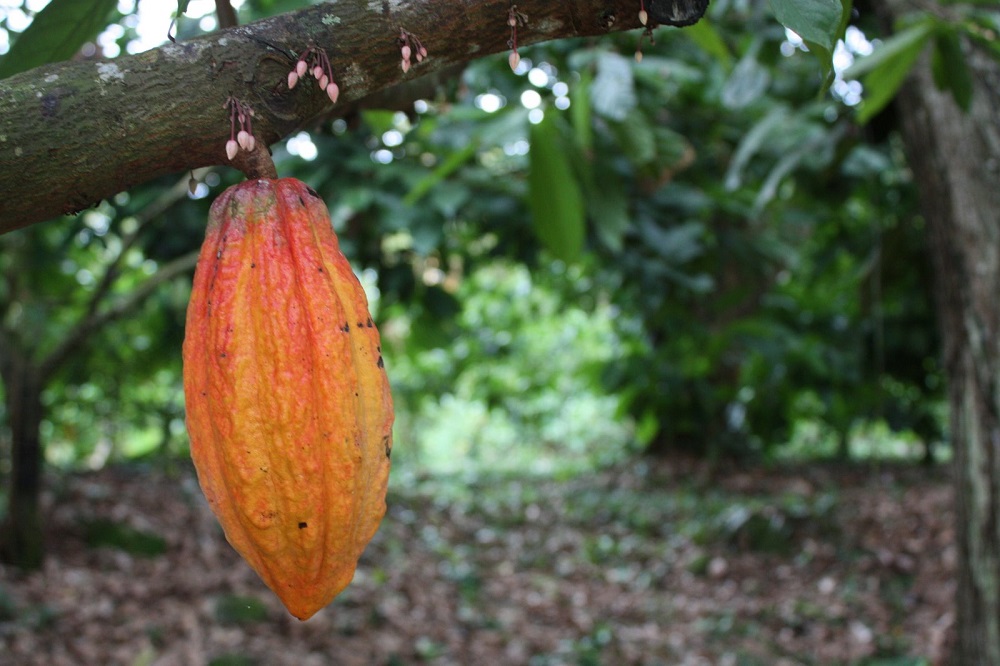
In any case, there is a golden rule when you first hear about someone’s allergy: you don’t gasp and then blurt out something pitying like “You can’t eat avocado? Oh that’s terrible! How do you live?“.

Some ‘pre-chocolate’ (AKA a cocoa pod) on the tree.
I don’t think anyone would feel all that bad for someone with a genuine allergy to celery*, but take a moment to imagine being allergic to chocolate.
No more chocolate.
Ever.
The allergy would be bad enough, but I suspect the shocked reactions, followed by sympathy, we be almost worse.
The exact origin of the cocoa tree (Theobroma cacao) is somewhat murky, but Wikipedia says (in a very roundabout way) that it seems to be from somewhere around Ecuador, Peru and Brazil. At some point it was domesticated and spread up into Central America where it became popular with Mayans and Aztecs, who made it into drinks and even smoked it with tobacco.
We often bring a cocoa (cacau) pod along on our tours so our guests can have a good look at this rarely seen fruit. The pods themselves are really beautiful – sometimes ridged and nobbly, other times smooth, and coming in a variety of colours including red, green, yellow, orange or some combination. Break/cut them open and things get interesting. Rows of seeds, covered in a pink-white pulp, remind you of lobster tails or alien brains (at least these are the most common guest-reactions).

Lobster tail? Alien brain?
That whiteish pulp makes a delicious juice which tastes like lychee or mangosteen (regular readers may remember an awesome cacau caipirinha which I had the pleasure to discover back in 2012 in Bahia).
If you want to go on to make something resembling cocoa (the hot chocolatey drink so beloved of octogenarians) then the basic steps are to ferment the beans, dry them, then crack them to remove the skins. Next the beans are gently roasted, at which point they can be broken up into nibs. Instagram/Facebook followers will know that I recently reached that last stage with a little project at home. For non-social media types, here is the evidence:

I read somewhere that the fermentation stage is usually carried out burlap sacks or temperature-controlled boxes, but as I had neither of these I found some other advice which said you could ferment them in water. Probably totally wrong, but whatever…

After fermentation, the beans have to be dried out. This is said to take about a week. Next the beans are cracked so the now dry, brittle skins can be removed.

After the peeling and roasting, the beans turn brown and start to smell delicious.

The beans are now dry and easily broken up into nibs. A friend who used to work in a chocolate shop (what higher authority could anyone hope to find?) said these look and taste right, so I’ll give myself a little pat on the back. The same friend tells me that people enjoy nibs sprinkled onto their yogurt or baked into cookies.
The next steps of the chocolate making process are arcane/confusing. The nibs are milled, possibly rested for certain periods of time, tempered (which apparently functions to align the chocolate crystals or something) and finally poured into a mould to set. I will be skipping these last steps as I have no idea how to do any of them and I feel I’ve already done more than my duty on this project.
However, if you seriously read this far then I guess I should get to the ‘hunting’ part of today’s post’s title. I’ve added a new section to the hugely popular “Where can I find…” section on the top menu. This time it’s chocolate! If you have any hot tips on great chocolate shops in Rio then let me know and if I agree I’ll add them to the list. Have a great weekend with lots of chocolate!
*On further consideration, removing celery from mirepoix would leave many of the best French dishes rather flat, and the Creole/Cajun ‘Holy trinity‘ would become a rather unholy binity…

التعليقات